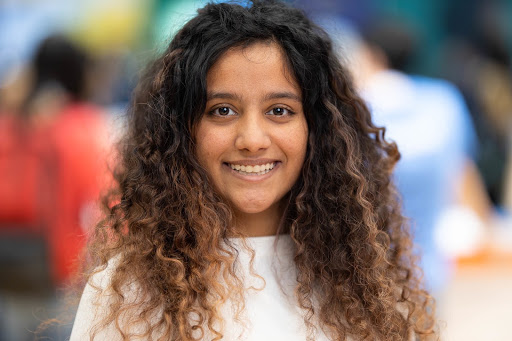Can STEM be art? The answer is a resounding “yes” according to senior Shagun Bose, who conducts research in Ehsan Hoque’s Human-Computer Interaction Lab.
“A person who does sculpture is as much of an engineer as someone who works with robots,” Bose said. “They’re just using different mediums.”
The Hoque Lab attempts to leverage technology and computer systems to help individuals (from different backgrounds, age groups, professions, etc.) improve their own abilities, such as communication. One such project is the Live Interactive Social Skills Assistance system, or LISSA, which helps people communicate better by simulating a face-to-face conversation.
The Hoque Lab’s interdisciplinary, technology-focused approach to solving real-world problems is also found in Bose herself.
Recently, Bose was accepted into the Frameless Symposium at RIT for her Augmented Reality Virtual Reality (AR/VR) project called “awARe,” where, with her partner, senior Emma Strauch, she merges systems engineering and computation with psychology and art. The symposium will feature a mix of papers, art installations, and works in progress all related to the field of AR/VR.
For her project, which she first developed in her CSC 294 class, Bose plans to distribute digital art installations across campus. The installations will feature a code that people can scan with their phone, and after, hear an audio clip describing someone’s experience, generally of discrimination and bias, at that particular location. At the moment, Bose is conducting interviews and creating the audio and video scripts for members of the campus community to listen to and read. Bose plans to present a demo of the project at the RIT Frameless Symposium.
With this project, Bose hopes to touch upon a deeper, not so virtual reality. A double major in computer science and psychology, Bose is passionate about human emotion and translates this into her projects. “This work that I’m doing revolves around the idea of empathy — I’m trying to understand people’s experiences on campus with discrimination and bias, whether [it’s] age, gender, socioeconmic status, religious affiliation, and so on,” Bose said.
Bose has experienced her share of implicit bias being a woman of color in STEM and one of three women in her lab. First starting out, she was plagued by feelings of inadequacy and doubted her ability to contribute to the higher level discussions at lab meetings.
“I felt like I wasn’t very good at math and that I couldn’t understand all the formulas or what was going on in meetings,” Bose said. “My ego really took a hit at that point.”
Over time, Bose found her niche: design. She sharpened her skills in intuitive technology (the science of human-computer interaction) through designing studies with technology for the Hoque lab in order to efficiently communicate messages to test subjects or outlining research on the best processes for eliciting a particular response from the test subject interacting with the screen.
Bose even ended up taking a higher level math course for fun and another tough class in artificial intelligence to explore that branch of her field further.
“As women, the stereotype is against us, so you can’t reject yourself,” she said. “At the end of the day you bring to the lab your curiosity and passion. It’s okay if you don’t have the skills yet because you’ll learn them — over time you’ll find your place.”
Her confidence growing, Bose also attended the Grace Hopper Conference, the nation’s largest conference for women in computing — fully by the Computer Science Department at UR. Big name companies from all around the world attend the conference each year for networking and intern recruitment. It was there where she designed, developed, and showcased her website portfolio (https://www.shagunbose.com/) under a “mother hen” or student mentor. Bose utilized her knowledge of code and computational algorithms in order to display her skill in design and computerized nomenclature.
In the future, Bose plans to get her Ph.D. in Computer Science Engineering and work within the technological industry. She aims to venture deeper into HCI (human-computer interaction) research and develop new, applicable methods that allow for novel human-technology communion.
When asked for a word of advice, Bose kept it simple: “I think that every engineer needs to take a humanities or social science course. Remember that you are building for people.”
Editor’s Note (01/18/20): This article was revised to clarify that Bose collaborates with a partner, senior Emma Strauch, on the awARe project.
Correction (11/27/19): An earlier version of this article misspelled “Frameless Symposium” as “Framelist Symposium.”

